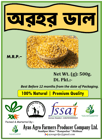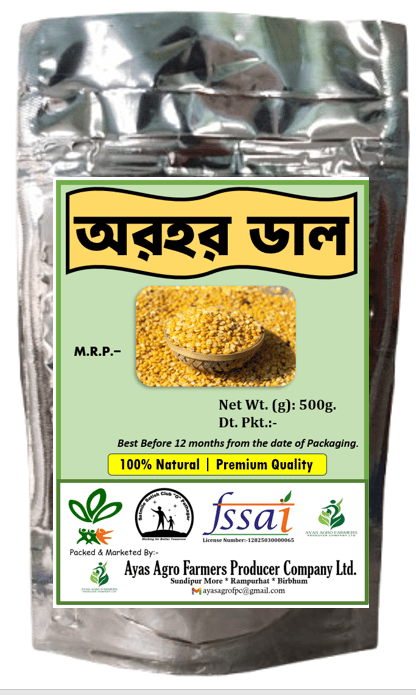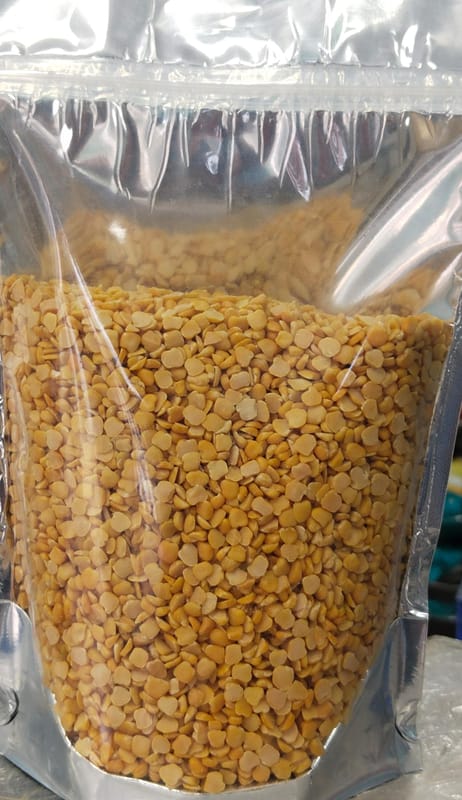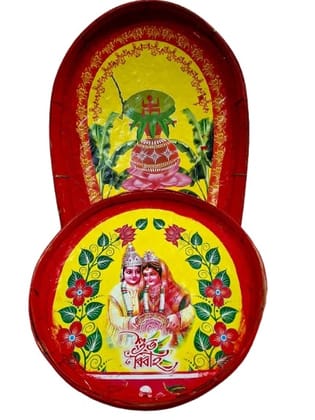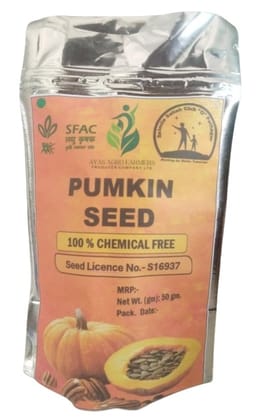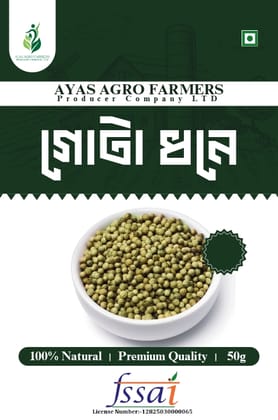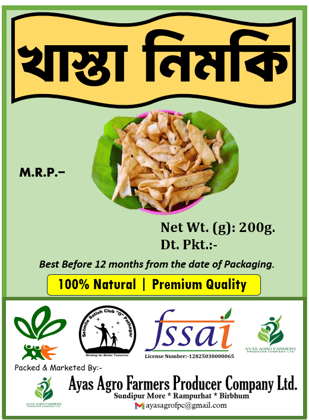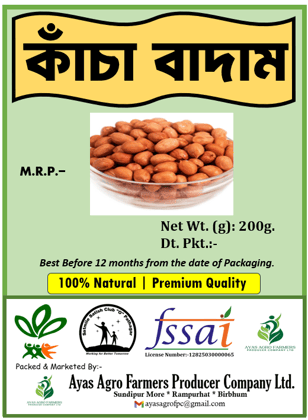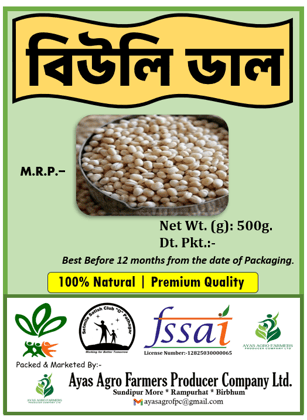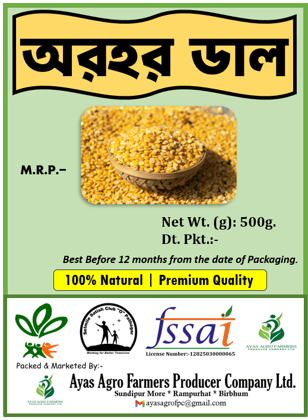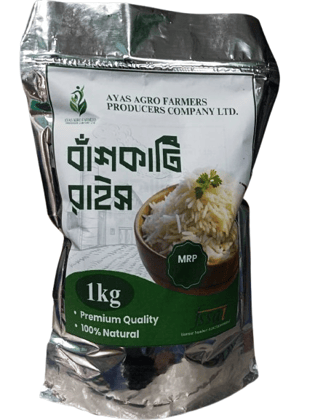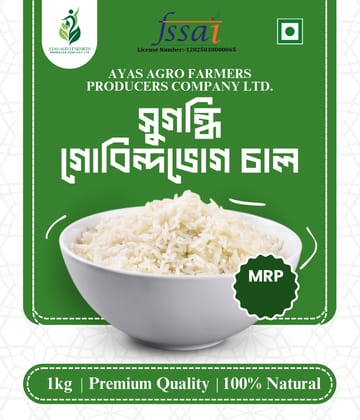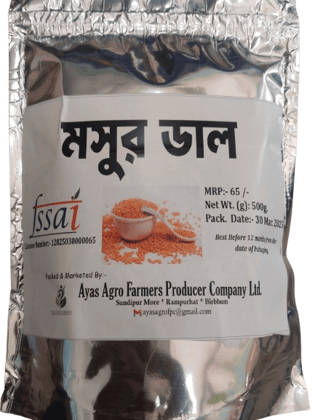Arhar Dal (অড়হর ডাল), also widely known as Toor Dal or Pigeon Pea Split, is one of the most popular and com...
Read MoreArhar Dal (Toor Dal) – 500gm
Key Attributes
| Country of origin | India |
|---|---|
| Net Quantity | 500 gram |
| Product Dimensions | 24L x 16W x 24H cm |
| Manufacturer or packer name | Ayas Agro Farmers Producer Company Limited |
Arhar Dal (অড়হর ডাল), also widely known as Toor Dal or Pigeon Pea Split, is one of the most popular and commonly consumed lentils in India, including West Bengal. It is derived from the pigeon pea plant (Cajanus cajan).
Key Characteristics:
- Appearance: Arhar Dal consists of small to medium-sized, split, and skinned pigeon peas. They are typically a pale yellow color.
- Flavor Profile: It has a mild, subtly sweet, and somewhat earthy flavor. Unlike some other dals, it doesn't have an overtly strong or pungent taste, making it a versatile base for various preparations.
- Texture and Consistency: When cooked, Arhar Dal softens considerably and tends to break down, resulting in a smooth, creamy, and slightly thick consistency, which is ideal for a comforting lentil soup or stew. It can be cooked to a completely smooth consistency or left with a little texture depending on preference.
- Aroma: It has a mild, comforting aroma that becomes more pronounced when tempered with spices.
Culinary Uses (with an Indian/Bengali focus):
Arhar Dal is a staple in everyday Indian meals due to its ease of cooking and mild flavor, which allows it to absorb other spices well.
- Everyday Dal: It is the most common dal prepared for daily consumption in many Indian households. It's typically cooked with water and turmeric, then tempered (tarka/phoron) with ghee or oil and spices like cumin seeds, mustard seeds, asafoetida (hing), dry red chilies, and sometimes curry leaves or ginger.
- Sambar (South India): Arhar Dal forms the base of the famous South Indian lentil and vegetable stew, Sambar.
- Dal Fry/Tadka Dal: These popular restaurant dishes often feature Arhar Dal, cooked until tender and then generously seasoned with a flavorful tempering of spices, sometimes with onions and tomatoes.
- Khichuri (Khichdi): While other dals can be used, Arhar Dal is frequently combined with rice and vegetables to make comforting one-pot meals like Khichuri (the Bengali equivalent of Khichdi), especially during monsoons or when seeking comfort food.
- Puris/Parathas (Stuffing): In some regions, a spiced, mashed Arhar Dal mixture is used as a stuffing for flatbreads like Puris or Parathas.
Health Benefits:
Arhar Dal is highly nutritious and offers several health benefits:
- Excellent Source of Plant Protein: It's a vital source of protein for vegetarians and vegans, essential for muscle building, repair, and overall body function.
- Rich in Dietary Fiber: Its high fiber content aids digestion, promotes gut health, helps prevent constipation, and contributes to satiety, which can be beneficial for weight management.
- Good Source of Complex Carbohydrates: Provides sustained energy release.
- Packed with Minerals: Contains essential minerals like iron (important for red blood cell formation and preventing anemia), potassium (for blood pressure regulation), magnesium (for muscle and nerve function), and phosphorus (for bone health).
- Good Source of B-Vitamins: Provides vitamins like folate (Vitamin B9), which is crucial for cell division and growth, and thiamine (Vitamin B1).
- Low in Fat: Naturally low in unhealthy fats.
In West Bengal, Arhar Dal is a common everyday dal that offers warmth, nourishment, and a simple, comforting flavor that complements a variety of side dishes, particularly rice and vegetable preparations.
Description of Oatmeal
Oatmeal is a popular breakfast food made from oats (Avena sativa). It is a type of porridge created by boiling oats (either rolled, steel-cut, or instant) in water or milk.
Key Characteristics:
- Base Ingredient: Oats (a type of cereal grain).
- Appearance: Varies depending on the type of oat used:
- Steel-cut oats: Chewy, resemble small grains of rice.
- Rolled oats (Old-fashioned oats): Flatter, oval-shaped flakes.
- Instant oats: Very fine, almost powdery, cook quickly.
- Flavor Profile: Mild, nutty, and slightly earthy. It has a neutral taste on its own, which makes it highly adaptable to various sweet or savory additions.
- Texture and Consistency: Creamy and soft when cooked, though the chewiness varies by oat type.
- Preparation: Typically cooked with water or milk, often sweetened with sugar, honey, or maple syrup, and served with fruits, nuts, seeds, or spices like cinnamon. Can also be made savory.
Culinary Uses:
- Breakfast Cereal: Its primary use, often served hot.
- Baking: Oats are used in cookies, granola bars, breads, muffins, and crumbles.
- Thickener: Ground oats can be used as a thickener in soups or stews.
- Oat Flour: Used as a gluten-free alternative in baking.
Health Benefits:
Oatmeal is highly regarded for its nutritional value:
- Rich in Soluble Fiber (Beta-Glucan): This type of fiber is excellent for heart health, helping to lower LDL ("bad") cholesterol and stabilize blood sugar levels. It also promotes a feeling of fullness.
- Good Source of Insoluble Fiber: Aids in digestive health.
- High in Antioxidants: Contains avenanthramides, unique antioxidants found in oats, which have anti-inflammatory properties.
- Nutrient-Dense: Provides important vitamins (like B vitamins) and minerals (manganese, phosphorus, magnesium, iron, zinc).
- Gluten-Free (Naturally): Pure oats are naturally gluten-free, though cross-contamination can occur during processing, so certified gluten-free oats are available for those with celiac disease.
Conclusion: Arhar Dal is NOT Oatmeal.
- Arhar Dal is a legume/lentil from the pea family.
- Oatmeal is a cereal grain product.
They come from entirely different plants and have distinct nutritional profiles, culinary uses, and flavors, although both are healthy and common components of different diets. It seems there might be a slight misunderstanding in the question. Arhar Dal and Oatmeal are two entirely different food items, though both are nutritious.
Let's clarify and describe each:
Arhar Dal (অড়হর ডাল)
Arhar Dal is the common Indian name for split pigeon peas (Cajanus cajan). It's also widely known as Toor Dal or Tuvar Dal in various parts of India. It is one of the most widely consumed lentils in the Indian subcontinent.
Key Characteristics:
- Appearance: Arhar Dal consists of small, split, and skinned yellow lentils.
- Flavor Profile: It has a mild, subtly sweet, and somewhat earthy flavor. When cooked, it readily absorbs the flavors of the spices it's prepared with.
- Texture: When cooked, Arhar Dal becomes very soft and creamy, often disintegrating slightly to give a smooth consistency to the dal preparation. It does not retain its individual shape as much as Chana Dal (split Bengal gram) might.
- Cooking Time: It cooks relatively quickly, especially in a pressure cooker, which makes it a popular choice for everyday meals.
Culinary Uses (Indian Context):
Arhar Dal is a staple in everyday Indian cooking and is used in countless ways:
- Simple Dal: Most commonly, it's cooked into a simple, comforting dal, often tempered (tarka/tadka) with ghee or oil, cumin seeds, asafoetida (hing), ginger, garlic, onions, tomatoes, and green chilies. This forms a staple accompaniment to rice or rotis.
- Sambhar: It's the primary lentil used in the famous South Indian stew, Sambhar, providing its characteristic body and flavor.
- Dal Fry/Dal Tadka: Popular restaurant and home dishes where the cooked dal is finished with a flavorful tempering of spices.
- Other Dishes: It's also used in various other preparations like dal palak (dal with spinach), dal makhani (though urad dal is primary, arhar dal can be added), and some regional specialties.
Health Benefits:
Arhar Dal is highly nutritious:
- Excellent Source of Protein: Being a legume, it's a fantastic plant-based source of protein, crucial for muscle repair, growth, and overall bodily functions.
- High in Dietary Fiber: Its rich fiber content aids digestion, helps prevent constipation, and promotes a feeling of fullness, which can assist in weight management.
- Rich in Minerals: It provides essential minerals such as iron (important for red blood cell formation and preventing anemia), potassium (for blood pressure regulation), magnesium, and phosphorus.
- Good Source of B-Vitamins: It contains several B vitamins, including folate (Vitamin B9), which is vital for cell growth and development, especially during pregnancy.
- Complex Carbohydrates: Provides sustained energy release.
| Country of origin | India |
|---|---|
| Common name | Arhar Dal (Toor Dal) |
| Net Quantity | 500 gram |
| Weight | 500 g |
| Package Dimension | 24L x 16W x 24H cm |
| Product Dimensions | 24L x 16W x 24H cm |
| Manufacturer or packer name | Ayas Agro Farmers Producer Company Limited |
| Manufacturer or packer address | Plot No. 904, Khatiyan No. 3227, JL No. 079, Rampurhat |
| Manufacturing Date | June |
| contact details consumer care | Ayas Agro Farmers Producer Company Limited, [email protected] |




